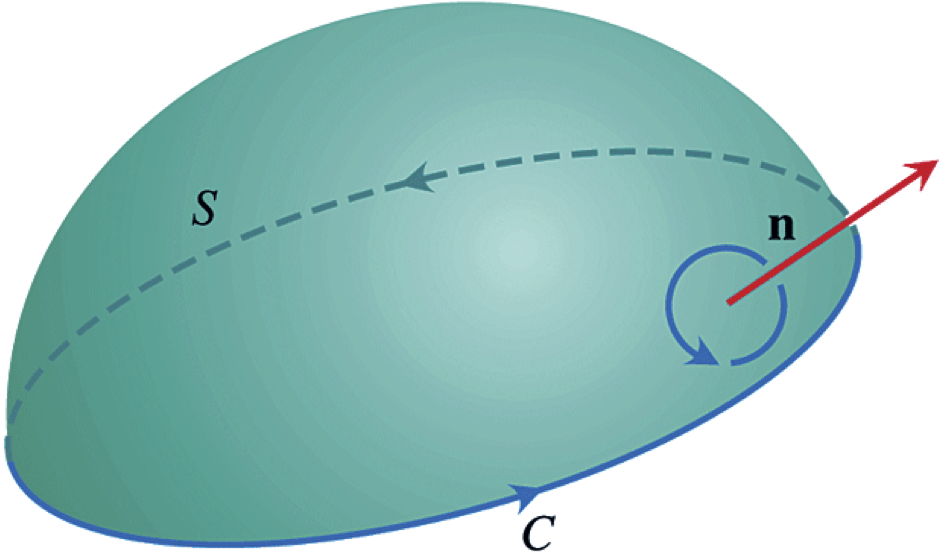Section 2.8 Divergence theorem
Definition 2.8.1.
A piecewise smooth surface \(\mathcal{S}\subseteq\R^3\) is closed if it has no boundary curve.
Theorem 2.8.2. Divergence (or Gauss's) theorem.
Let \(D\subseteq\R^3\) be a bounded solid region whose boundary \(\partial D=\mathcal{S}\) is a union of finitely many piecewise smooth surfaces. Let \(\boldn\colon \mathcal{S}\rightarrow\R^3\) be the outward orientation on \(\mathcal{S}\text{.}\) If \(\boldF\) is a continuous vector field whose component functions have continuous first-order partial derivatives on an open set containing \(\mathcal{S}\text{,}\) then
Example 2.8.3. Flux out of cube.
Let \(\mathcal{S}\) be the cube in the first octant bounded by the planes \(x=1,y=1,z=1\text{.}\) Compute the outward flux of \(\boldF(x,y,z)=x^2\boldi+4xyz\boldj+ze^x\boldk\text{.}\)
Let \(D\) be the solid cube \([0,1]\times [0,1]\times [0,1]\text{.}\) Since \(\boldF\) clearly satisfies the conditions for the divergence theorem, we have
Corollary 2.8.4. Zero divergence implies zero flux.
Assume the solid region \(D\subseteq\R^3\text{,}\) its boundary \(\partial D=\mathcal{S}\text{,}\) and the vector field \(\boldF\) satisfy the conditions of the divergence theorem. If \(\diver\boldF(x,y,z)=0\) for all \((x,y,z)\in D\text{,}\) then \(\iint\limits_\mathcal{S}\boldF\cdot \boldn\, d\sigma=0\text{,}\) for any orientation of \(\mathcal{S}\text{.}\)
Proof.
An easy consequence of the divergence theorem:
Corollary 2.8.5. Identical flux.
Suppose the solid region \(D\subseteq\R^3\) has piecewise smooth boundary surface \(\mathcal{S}=\mathcal{S}_1\cup \mathcal{S}_2\text{,}\) where \(\mathcal{S}_1\) is the outer boundary of \(D\) and \(\mathcal{S}_2\) is its inner boundary. If \(\boldF\) satisfies the conditions of the divergence theorem and \(\diver\boldF=0\) on \(D\text{,}\) then
where for both surface integrals \(\boldn_i\) is taken to be the outer orientation with respect to the surface.
Proof.
Let \(D_1, D_2\) be the solid regions enclosed by \(\mathcal{S}_1\) and \(\mathcal{S}_2\text{,}\) respectively (so that \(\mathcal{D}=D_2-D_1\)). Notice that if \(\boldn_2\) is the outward orientation on \(\mathcal{S}_2\text{,}\) considered as the boundary of \(D_2\text{,}\) then \(-\boldn_2\) is the outward orientation on \(\mathcal{S}_2\) considered as a boundary of \(D\text{.}\) By the divergence theorem we have
We conclude that
as desired.
Theorem 2.8.6. \(\diver\curl\boldF=0\).
If the component functions of \(\boldF=\angvec{F_1, F_2,F_3}\) have continuous second-order partial derivatives on the set \(D\text{,}\) then
for all \((x,y,z)\in D\text{.}\)
Proof.
We have
where in the last step we have used Clairaut's theorem to identify the various “mixed partials”: i.e., \(\frac{\partial F_3}{\partial x \partial y}=\frac{\partial F_3}{\partial y \partial x}\text{,}\) \(\frac{\partial F_2}{\partial x \partial z}=\frac{\partial F_3}{\partial z \partial x}\text{,}\) \(\frac{\partial F_1}{\partial y \partial z}=\frac{\partial F_1}{\partial z \partial y}\text{.}\)
Remark 2.8.7. Gradient, curl, divergence sequence.
Let \(D\subseteq \R^n\) be an open set. Define \(C^\infty(D, \R^m)\) as the set of all functions \(\boldF\colon D\rightarrow \R^m\) whose component functions have partial derivatives of all orders. We can think of \(\grad\text{,}\) \(\curl\text{,}\) \(\diver\) as defining a sequence of operators on such collections of functions.
Applying two operators in sequence results in a zero function (\(\curl\grad f=\boldzero\) and \(\diver\curl\boldF=0\)). In other words the image of any one of these operators lies within the set of a functions mapping to zero when applying the next operator.
If \(D\) is simply connected, then any vector field that is mapped to \(\boldzero\) by \(\curl\) is in the image of \(\grad\text{.}\)
If \(D\) is contractible (too technical to define here), then any vector field that is mapped to \(0\) by \(\diver\) is in the image of \(\curl\text{.}\)
Corollary 2.8.8. Curl field has zero flux.
Assume the solid region \(D\subseteq\R^3\text{,}\) its boundary \(\partial D=\mathcal{S}\text{,}\) and the vector field \(\boldF\) satisfy the conditions of the divergence theorem. If \(\boldF=\curl \boldG\) for some vector field \(\boldG\text{,}\) then
Proof.
This is an easy consequence of Theorem 2.8.6 and Corollary 2.8.4 since
Example 2.8.9. Gauss's law.
Given a a point charge \(q\) located at the origin in \(\R^3\text{,}\) the electrostatic field it produces is given by
where \(\boldr=\angvec{x,y,z}\) and \(\epsilon_0\) is a physical constant called the permittivity of free space. Prove Gauss's law: if \(\mathcal{S}\subseteq\R^3\) is a smooth closed surface with outward orientation then
Gauss's law can be generalized to a situation where the surface \(\mathcal{S}\) encloses a region \(D\) with continuous charge density \(\delta(x,y,z)\text{.}\) If \(\boldE\) is the resulting electrostatic field, then
where \(Q=\iiint_D\delta(x,y,z)\, dV\) is the total charge enclosed by \(\mathcal{S}\text{.}\)
First observe that \(\boldE\) satisfies the conditions of the divergence theorem on any solid region that does not contain the origin. Furthermore, a (somewhat onerous) computation shows that
for all \((x,y,z)\ne (0,0,0)\text{.}\) It follows that if \(\mathcal{S}\) does not enclose the origin, then the divergence theorem applies to the solid region \(D\) it encloses, and we have
Next, assume \(\mathcal{S}\) does enclose the origin. Pick \(R> 0\) small enough so that the solid ball \(B_R\) centered at the origin lies inside \(\mathcal{S}\text{,}\) and let \(D\) be the region within \(\mathcal{S}\) and outside of \(B_R\text{.}\) Since \(D\) does not contain the origin, \(\boldE\) satisfies the conditions of the divergence theorem. By Corollary 2.8.5, it follows that
where \(S_R\) is the sphere of radius \(R\) centered at the origin. It remains only to show that
which one can show directly using the definition of the surface integral and the standard parametrization of \(S_R\text{.}\) Indeed, the outward unit normal vector on \(S_R\) at a point \((x,y,z)\) is given by \(\boldn=\frac{1}{R}\angvec{x,y,z}\text{,}\) and thus for all \((x,y,z)\in S_R\) we have
Finally, using the usual parametrization
which satisfies
we have
as desired!
Theorem 2.8.10. Divergence interpretation.
Assume the component functions of \(\boldF=\angvec{F_1, F_2,F_3}\) have continuous first-order partial derivatives on an open set containing the point \(P=(x,y,z)\text{.}\) For all \(R>0\text{,}\) let \(S_R\) be the sphere of radius \(R\) centered at \(P\) with outward orientation. We have
Thus we interpret \(\diver\boldF(P)\) as the flux density of \(\boldF\) at \(P\text{,}\) measured in unit flux per unit volume.
Proof.
For all \(R > 0\) let \(B_R\) be the solid ball of radius \(R\) centered at \(P\text{.}\) We have \(S_R=\partial B_R\) and so by the divergence theorem
Next a generalization of the integral average value theorem to triple integrals imlies
for some point \(P_R\) in the ball \(B_R\) centered around \(P\text{.}\) Since \(\diver\boldF\) is continuous at \(P\) we have
